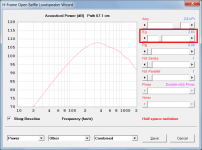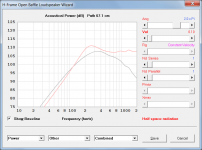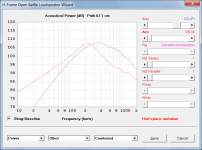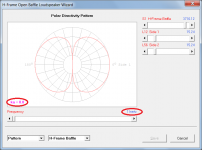Thank you!!Simply adjust the S1, L12 and L56 slider controls in the Loudspeaker Wizard and observe how the response changes.
I modelled the same 18" in a 60x60cm baffle, with 1cm/15cm/30cm wings each side (so the box looks 2/30/60cm deep) to get a sense of how chamber resonances are portrayed. Here's the power response at 12W (because the driver hits Xmax around 31Hz) and impulse for the three:
Impulse seems to be telling: with 30cm wings there are still oscillations at 10ms, while with 15cm oscillations are gone by 5ms, and without wings they are gone by 2.5ms or so. Similarly for pre-impulse oscillations. Wether that can be heard at low frequencies it's maybe a matter to discuss, but is this the right way of looking at it?
From this excersice I'm taking away the shallower the H, the faster the settling time (from the impulse) and hence cleaner sounding (true?), at the expense of the driver reaching Xmax at lower SPL (like 93dB SPL at 30Hz with 1cm wings vs 100dB with 30cm).
Am I getting this right? A m I missing other key indicators to look at to come up with the dimensional design?
Thank you!
Can you plot the frequency response for 2.83 (or 1W or whatever) input instead of max SPL?
Hornresp appears to default to SPL @ 2.83V at 1m, so its the first graph that will come up for you but yields limited design info? For your H-frame:
The max SPL feature is handy as it allows setting the power input to any value, which yields good design info on Xmax vs freq set points.
EG 100W
Outright Max SPL vs freq may be pivotal for those who want to design a bass response that delivers needed SPL freq without pooping out, damaging the woofer or exceeding Xmax and HD design limits.
Thanks for doing this!! I thought I had it, but your explanation showed I was missing some things.
Your very welcome. Hornresp has many features to discover. Let me knowwhat you find.
Impulse seems to be telling: with 30cm wings there are still oscillations at 10ms, while with 15cm oscillations are gone by 5ms, and without wings they are gone by 2.5ms or so. Similarly for pre-impulse oscillations. Wether that can be heard at low frequencies it's maybe a matter to discuss, but is this the right way of looking at it?
Thats what I see. It makes intuitive sense too. Like a cave that is deeper echoing more. It suggests a plain baffle will generally give a cleaner response higher.
The other thing is the deeper the cavity the lower the peak. The peak is the quarter wave response. It limits upward extension. So a deep H-frame is like a subwoofer. Good for maybe 40Hz - 120Hz. So as you pointed out that then limits ringing into the midrange.
With the deep 30cm H-frame it looks bad pushing it under 40Hz. Theres that knee with a steep drop off under 40Hz. Pushing into that region is fighting a losing battle. Besides there are few musical genres with significant fundamentals under 41kHz.
So Id suggest redo the sim for the 30cm deep H-frame > Max SPL put in 1000W > check the power at 40Hz for Xmax > re-enter the W @ 40Hz > check what that does to the SPL at 40Hz - might just save needing a sealed sub for some
No. Honestly, looking at impulse responses of the raw system like this (without any EQ) is rather pointless because you would never use this kind of system without some major EQ and that EQ will have a major impact on the time domain response. The peak that results from the wings, or the H/U-frame sides, must be flattened. At the same time the LF end droop must be corrected by boosting the lowest frequencies or by limiting the LF extension. These changes will fix most of the issues in the time domain.Impulse seems to be telling: with 30cm wings there are still oscillations at 10ms, while with 15cm oscillations are gone by 5ms, and without wings they are gone by 2.5ms or so. Similarly for pre-impulse oscillations. Wether that can be heard at low frequencies it's maybe a matter to discuss, but is this the right way of looking at it?
From this excersice I'm taking away the shallower the H, the faster the settling time (from the impulse) and hence cleaner sounding (true?), at the expense of the driver reaching Xmax at lower SPL (like 93dB SPL at 30Hz with 1cm wings vs 100dB with 30cm).
Am I getting this right?
Thank you. I will certainly apply DSP to flatten the response.No. Honestly, looking at impulse responses of the raw system like this (without any EQ) is rather pointless because you would never use this kind of system without some major EQ and that EQ will have a major impact on the time domain response. The peak that results from the wings, or the H/U-frame sides, must be flattened. At the same time the LF end droop must be corrected by boosting the lowest frequencies or by limiting the LF extension. These changes will fix most of the issues in the time domain.
What trade-off should I be looking at when deciding H dimensions, though? A deeper H will provide higher SPL at lowest frequencies, but what should I look at to decide when it becomes too deep?
What I find to be most limiting is the internal 1/4 wave resonance. The deeper the cavity the lower in frequency it will occur. IMHO it is best if the peak of the (un EQ'd) resonance is located into the transition to the next higher band, e.g. at at least 1.25 times the crossover frequency. For example, if the peak is at 150Hz I would plan to cross over not higher than 100-125 Hz. So once you determine how high in frequency you need the 'frame to run you will have set the maximum depth of the H or U frame. This also influences how low the frame can be used (other factors like available amp power, Xmax, driver Qts etc will also influence the low end, of course).Thank you. I will certainly apply DSP to flatten the response.
What trade-off should I be looking at when deciding H dimensions, though? A deeper H will provide higher SPL at lowest frequencies, but what should I look at to decide when it becomes too deep?
In your initial post you mention you have subs that you will operate up to 50 or 60 Hz, and this considerably eases the LF demand from the dipole woofer that comes above that point. But I don't think you mentioned how high in frequency you wanted to use it.
Thank you Charlie!What I find to be most limiting is the internal 1/4 wave resonance. The deeper the cavity the lower in frequency it will occur. IMHO it is best if the peak of the (un EQ'd) resonance is located into the transition to the next higher band, e.g. at at least 1.25 times the crossover frequency. For example, if the peak is at 150Hz I would plan to cross over not higher than 100-125 Hz. So once you determine how high in frequency you need the 'frame to run you will have set the maximum depth of the H or U frame. This also influences how low the frame can be used (other factors like available amp power, Xmax, driver Qts etc will also influence the low end, of course).
In your initial post you mention you have subs that you will operate up to 50 or 60 Hz, and this considerably eases the LF demand from the dipole woofer that comes above that point. But I don't think you mentioned how high in frequency you wanted to use it.
Indeed, I have the two sealed subs to play the lowest and hope to add two dipole subs to play as low as possible to have a distributed bass array. On the higher end of the dipole subs, I'd like to experiment: I see people cross them at 100 to 120Hz, and Danny Richie (GR) recommending his servo dipole subs going up higher (150Hz if I recall correctly).
So if I hope to xo at 150Hz, then I should design so the resonance was at 190Hz: 1/4x30000/190=39.5cm. This is for each wing in the H, right? And for 120Hz xo then the resonance at 150Hz would call for 50cm wings. Seems longer than I expected.
Here's a simulation comparing an H frame with same baffle size and varying wings from 20 to 39.5cm each. The higher SPL at lower frequencies with the increased wings is evident here, but where do I see the resonance? Didn't find it on the acoustical impedance, nor the response...or maybe don't know what to look for?
from my experience using OB subwoofer with 2 iterations : 2x15" and 21" using pro driver and minidsp 2x4HD. it' hard to get deep bass and nice slam midbass
overlapping OB woofer to cover below 80Hz and sealed subwoofer below 40Hz is a good combination, but in the range of 80-300Hz is difficult to get nice slam with OB. so sealed midbass is a must using 8" driver.
with OB sub is still good to listen slow jazz pop music, but when it comes to rock and watching bluray, sealed subwoofer is a must which i use dual-opposed 12" subwoofer
while OB midrange is still a good choice using flat baffle gives better room integration in my livingroom 5x6
overlapping OB woofer to cover below 80Hz and sealed subwoofer below 40Hz is a good combination, but in the range of 80-300Hz is difficult to get nice slam with OB. so sealed midbass is a must using 8" driver.
with OB sub is still good to listen slow jazz pop music, but when it comes to rock and watching bluray, sealed subwoofer is a must which i use dual-opposed 12" subwoofer
while OB midrange is still a good choice using flat baffle gives better room integration in my livingroom 5x6
The default value for Eg is 2.83V (giving 1 watt into 8 ohms), but the value can be altered if required.Hornresp appears to default to SPL @ 2.83V at 1m
It is also possible to specify constant diaphragm velocity or constant diaphragm acceleration, rather than constant input voltage.
Attachments
David, thank you for this wonderful SW! In post #22 you show also directivity pattern, but at what specific F is it?
Question: aren't all these modellings unhelpful once you put the speaker in a room and phases of 15 foot waves get complicated bouncing from back and side walls?
The output of a dipole depends on a complicated mix-and-match of phases and certainly will sound better than the old textbook model of the rear waves sneaking around to totally annihilate the front waves.
While it is clear to many that the room-filling sound of dipoles is a treat, I am not sure if the same applies to low frequencies in a room, as much as I like dipoles. I ran a large dipole with a 20-Hz woofer for some years. Made a very nice complement to the other subs in the room.
B.
The output of a dipole depends on a complicated mix-and-match of phases and certainly will sound better than the old textbook model of the rear waves sneaking around to totally annihilate the front waves.
While it is clear to many that the room-filling sound of dipoles is a treat, I am not sure if the same applies to low frequencies in a room, as much as I like dipoles. I ran a large dipole with a 20-Hz woofer for some years. Made a very nice complement to the other subs in the room.
B.
Hi Juhazi,David, thank you for this wonderful SW! In post #22 you show also directivity pattern, but at what specific F is it?
kazap is the author of Post #22, but because ka is shown as 0.0 I would guess the frequency is probably 1 Hz. The frequency is specified using the slider shown in the attachment.
Kind regards,
David
Attachments
Evidently you don't understand how hearing works and is different from a microphone, otherwise you would have known the answer long ago. You keep bringing up this line of questioning over and over in OB/dipole threads as if you are haunted by it.Question: aren't all these modellings unhelpful once you put the speaker in a room and phases of 15 foot waves get complicated bouncing from back and side walls?
Let's do a little thought experiment: Doesn't a boxed speaker radiate less directionally and more like a monopole at lower frequencies (e.g. below 500-1k Hz)? Isn't the acoustic output from a non-directional source also "bouncing" around the room and getting "complicated" with lots of unpredictable phase behavior and so on? Wow, how can we possibly make any sense of the acoustic playback when there are all of these echos and reflections? Think about it, and then try to compare that with your experiences listening to actual loudspeakers in domestic rooms. It seems to work out just fine. How can that be? Now tell me what is so different about a dipole source?
Hello again @CharlieLaub 🙂Thank you Charlie!
Indeed, I have the two sealed subs to play the lowest and hope to add two dipole subs to play as low as possible to have a distributed bass array. On the higher end of the dipole subs, I'd like to experiment: I see people cross them at 100 to 120Hz, and Danny Richie (GR) recommending his servo dipole subs going up higher (150Hz if I recall correctly).
So if I hope to xo at 150Hz, then I should design so the resonance was at 190Hz: 1/4x30000/190=39.5cm. This is for each wing in the H, right? And for 120Hz xo then the resonance at 150Hz would call for 50cm wings. Seems longer than I expected.
Here's a simulation comparing an H frame with same baffle size and varying wings from 20 to 39.5cm each. The higher SPL at lower frequencies with the increased wings is evident here, but where do I see the resonance? Didn't find it on the acoustical impedance, nor the response...or maybe don't know what to look for?
View attachment 1046051
Is the above reasoning ok? For 150Hz xo wings should be max 39.5cm for each H side?
I would err on the side of smaller wings to keep the cavity resonance higher in frequency that you need. 40cm seems a bit long. Also the calculation does not include an "end correction" that is sort of like what you have with ports. This is more important when the cavity is longer that it is wide, which makes the effective length longer than the physical length of the sides by about 5% to 10%. That translates to a lower resonance frequency than the 1/4 wave frequency you are calculating.
Hello everyone
I am honored to contact you and ask for your opinion and advice.
For my new Open Baffle project I want you to help me choose between two subwoofers: SB Audience 18-SW450 or SB Audience 18 SW-500. Which of the two subwoofers would be more suitable for open baffle design? I specify that there will be 2 units in parallel on each side.
Thanks a lot and I look forward to hearing from you.
Regards,
Victor Luca
I am honored to contact you and ask for your opinion and advice.
For my new Open Baffle project I want you to help me choose between two subwoofers: SB Audience 18-SW450 or SB Audience 18 SW-500. Which of the two subwoofers would be more suitable for open baffle design? I specify that there will be 2 units in parallel on each side.
Thanks a lot and I look forward to hearing from you.
Regards,
Victor Luca
Attachments
You should know the first rule of subwoofer integration is never have them above 125 hz and even there they should be used with a very steep crossover slope. Try sending a full range signal to that 18" speaker and see how well it handles it. Its going to be a muddied mess in the midrange. You want to use an 18" driver for midrange? That is nuts....deep down you know this. If you like your present bass from your sealed enclosures why not let them go up to about 80 hz and use 8"-10" OB drivers down to that. But never crossover in the midrange. Of course. That's just suicide. At least 2000hz, where your tweeters take over. I get the feeling that a lot of people on this website have never had much experience with quality audio. You've just got to know the fundamentals before designing speakers and clearly most don't unfortunately. The stumbling block for most is the cost. The way around that is to always be buying and selling used equipment.Yeap, I didn't see the H baffle option in Basta.
Faitals indeed go up to 500Hz easily and are today used as midbasses from 70 to 350Hz baffleless. But lately I'm wondering if they are really clean/transparent above 200Hz or so. That is why I want to test them for sub duties and maybe use a 12" or 15" for midbass.
I can get to 60Hz baffleless, so hoping an H-baffle will allow getting to at least 40Hz - maybe 30Hz? So 40 to up to whatever makes sense/sounds good. Maybe it goes higher than 120Hz and I can go for a 12" midbass with minimal baffle.
+1 for Clarity2022. Very apt comments.
BTW, if the subs come in below 120 Hz and the XO slopes are steep, you can put the boxes anywhere in the room and almost any distance from the higher freq speakers. That gives you a lot of freedom to base your bass on acoustic and appearance criteria. And with the lower bass moved away, OB panels can be a whole lot smaller.
B.
BTW, if the subs come in below 120 Hz and the XO slopes are steep, you can put the boxes anywhere in the room and almost any distance from the higher freq speakers. That gives you a lot of freedom to base your bass on acoustic and appearance criteria. And with the lower bass moved away, OB panels can be a whole lot smaller.
B.
You can use 18" easily up to 300Hz or even 500 Hz if it is well behaving. They start beaming above that. Offcourse crossing it high like in manzanita, means it has to be placed close with mid/tweeter. And its not sub anymore.
No, it will not sound muddy, no, 18" does not have to be crossed bellow 125Hz.
Yes, we never heared good speakers.
See this one on axis and of axis, very little beaming till above 500Hz. Breakups far above that. Minor too.
https://faitalpro.com/en/products/LF_Loudspeakers/product_details/index.php?id=151070150
See many others 18" how far fr response behaves well without beaming.
In pa 18" is often crossed at 300Hz.
No, it will not sound muddy, no, 18" does not have to be crossed bellow 125Hz.
Yes, we never heared good speakers.
See this one on axis and of axis, very little beaming till above 500Hz. Breakups far above that. Minor too.
https://faitalpro.com/en/products/LF_Loudspeakers/product_details/index.php?id=151070150
See many others 18" how far fr response behaves well without beaming.
In pa 18" is often crossed at 300Hz.
Speaking as somebody who has planar drivers from 130 Hz up, trying to shake .3 lbs of a large expanse of flimsy cardboard seems like a daft way to make clean waves (and cleanly stop waves) above 80 Hz. Also, not enough motor power for that amount of cone.
When I was young, folks thought 15 inches was as far as you could enlarge a cone and still have it behave nice. Today, cones structurally more solid but at the cost of added weight. Not sure improved materials have really moved the rule of thumb to 18 inches today. Dunno.
You can feed a 300 Hz signal into an 18-inch driver. Yes, you can train a horse to dance but it isn't Swan Lake.
B.
When I was young, folks thought 15 inches was as far as you could enlarge a cone and still have it behave nice. Today, cones structurally more solid but at the cost of added weight. Not sure improved materials have really moved the rule of thumb to 18 inches today. Dunno.
You can feed a 300 Hz signal into an 18-inch driver. Yes, you can train a horse to dance but it isn't Swan Lake.
B.
Last edited:
- Home
- Loudspeakers
- Subwoofers
- Open baffle sub



